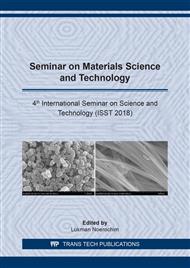p.161
p.168
p.174
p.180
p.185
p.193
p.199
p.209
p.215
Analysis of Large Bell Angle in Double Bell System on Burden Material Distribution and Layer Deformation in Mini Blast Furnace with Capacity 250 Ton/Day Using Solid Particle Model
Abstract:
The abundant of nickel ore resources in Indonesia and the regulations of Law of Coals and Minerals No. 4 year 2009 cause the development of nickel ore processing technology. One of the proven nickel ore processing technology is Mini Blast Furnace (MBF). When, the raw materials were fed to the MBF, there is a charging system to ensure good distribution of raw materials in MBF. The double bell charging system has an important role on the distribution of burden material in MBF. By optimizing the distribution and layers of the material burden, it will increase the stability and efficiency of the MBF process. Therefore, this study focused on analyzing the effect of large bell angle on the distribution of burden material in MBF using discrete element method. After analyzed, large bell angle differences produce different burden material distribution. For particle distribution, particles of small density (coal and dolomitee) tend to be concentrated in the center zone and particles of large density (ore) tend to be concentrated in the intermediate and peripheral zone. The larger angle of the large bell will increase particle falling velocity and the kinetic energy of the burden material. The most stable layer in MBF was obtained when using 65o bell angle. The MBF with 65o large bell angle is the best bell angle for MBF with capacity of 250 ton/day due to the greatest possibility of central working furnace operation.
Info:
Periodical:
Pages:
185-192
Citation:
Online since:
July 2019
Price:
Сopyright:
© 2019 Trans Tech Publications Ltd. All Rights Reserved
Share:
Citation:


